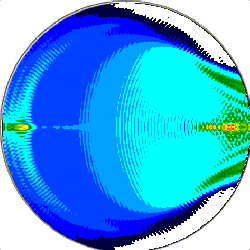Light Beam from Water Droplets

The secret to probing clouds from afar may be igniting tiny fires in their water droplets. Researchers would like to detect compounds in the air by watching the way the atmosphere reflects brief pulses of laser light, but so far this technique has trouble producing a strong signal or detailed data on particle sizes and compositions. Now a team has found that extremely brief light pulses reflect strongly in one direction from single, miniscule water droplets, by generating an intense plasma within the drop. The finding, reported in the 15 July print issue of PRL, could potentially offer a more powerful way of tracking everything from airborn dust and minerals to pollen and biological agents.
In light detection and ranging (LiDAR), detectors collect the light reflecting back from a laser pulse sent into the atmosphere. This technique gives the concentration of a suspension of fine drops of liquid, called an aerosol, in space, but no other information. Shorter pulses might improve the system, but researchers expected nanosecond bursts to vaporize small water droplets and scatter their light in all directions.
So Jean-Pierre Wolf of Claude Bernard University in Lyon, France, and his colleagues were surprised when they hit single 30-micron-sized water droplets falling from a nozzle with pulses lasting just a few femtoseconds. The tiny globes emitted light 35 times more intensely back toward the laser source than in any other direction. Equally curious, the emitted light was white, whereas samples of water in a centimeter-sized cuvette emit in the infrared when given the same treatment.
The team’s calculations point to plasma as the explanation for both results. The curved surface of the droplet strongly focuses the incoming light pulse to a point near the drop’s edge. Water molecules at the focal point rapidly ionize and heat up to several thousand degrees Kelvin, forming a tightly localized ball of plasma. Thanks to the droplet’s focusing abilities, this plasma is hotter than that generated in a cuvette of water hit with a similar laser pulse, so the droplet’s plasma glows in visible light, rather than infrared. Essentially, the droplet becomes white hot. The white light is refocused back toward the laser source, again by the curved edge of the drop.
Wolf and colleagues expect that the strong directional emission will enhance LiDAR signals and make it easier to discriminate between particles of varying sizes, because smaller particles focus light differently from larger ones. They also expect that the spectrum of the returning light will suggest the composition of the LiDAR target, something the standard single-wavelength methods cannot do. The team plans to test the technique in a real-world experiment within the next month. The Teramobile system–a mobile terawatt-strength laser jointly operated by academic institutions in France and Germany–should give them this chance.
The paper reports a surprising effect that did not have an immediately obvious explanation, says Arnold Migus of the Ecole Polytechnique in Paris. “It’s a kind of miracle.” The results of the Teramobile experiment will be instructive, he adds, because the current experiment only looked at one drop at a time. He isn’t sure what will happen when the pulse bounces around inside a real aerosol, which “is not the equivalent of a sum of drops.”
–JR Minkel
JR Minkel is a freelance science writer in New York City.


